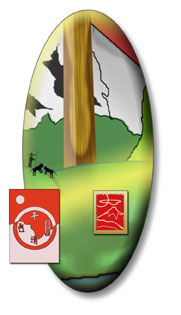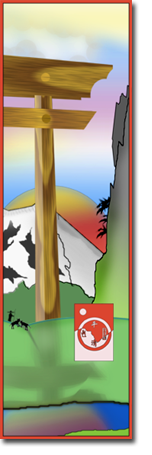On The Way: The Daily Zen Journal
Journal of My Study in China – Part 2
Dogen (1200-1253)
I asked at midnight, “In your dharma talk you said, ‘The bower and the bowed-to are empty by nature. The mind-to-mind communication is wondrous and inconceivable; its heart is profound, and it cannot be known. There is no way to reach it superficially. Doubt cannot touch it.’ Teachers in the scriptural schools also talk about mind-to-mind communication. Is it the same as what is taught in the ancestral path?”

Rujing replied, “You should know very well the ultimate importance of mind-to-mind communication. Without it buddhas would not have appeared, and Bodhidharma would not have come to China. It is a mistake to regard the scriptural teachings as outside of the ancestral path. Regarding the scriptural buddha-dharma as incorrect is like using a round robe and a square bowl. You can’t do that, can you? Please don’t try to use a round robe and a square bowl. You should know that there is always mind-to-mind communication.”
Rujing said, “The World-honored One said that hearing and thinking about the way is like being outside the gate, but zazen is like coming home and sitting calmly inside. Therefore, the merit of doing zazen even for one moment is immeasurable.
“I have been practicing the way for over thirty years without ever turning back, and although I am sixty-five years old I am more determined than ever. You too should practice with this intensity, as if you had received the prediction of enlightenment from the gold mouth of the Buddha himself.
“During zazen do not lean on the wall, screen, or the back of a chair. You should sit with a straight back, following the guidelines for zazen, never violating them.
“If you get up from zazen and do walking meditation, do not walk in a circle, but go in a straight line. If after twenty or thirty steps you want to turn around, always turn to the right. Always begin your steps with the right foot, then the left foot.
“The ruins of the place where the Tathagata got up from zazen and did walking meditation still exist in Udyana Kingdom in India. Also, Layman Vimalakirti’s house still exists today, and the foundation stones of Jeta Grove Monastery have not been buried.
“When people go to examine these sacred places, the results of their measurements always differ: some measure long, others measure short, some find the stones close together, and others find them farther apart. Their findings don’t correspond to each other. This is the vitality of the buddha ancestors.
“You should know that the bowl and robe, as well as the fist and nostrils of the ancestors, which have been transmitted to us in China, cannot be definitively measured.”
I asked, “The experience of the ancient and present buddha ancestors is an excellent guidepost for our own practice. In the beginning, when we first arouse our mind to understand dharma, it appears that there is a buddha way, but later when we become established in our understanding, it appears that there is no buddha way. On the other hand, when we begin to practice, it appears we have not yet attained enlightenment.
“And when we really enter the dharma, it appears that there is a spirit of enlightenment that goes even beyond the ancients. My question is: where is real enlightenment? At the beginning or later on?”
Rujing replied: “Bodhisattvas and shravakas asked this same question of the World-honored One when he was alive. In India and China, there has been correctly transmitted teaching about this.
“On the one hand it is taught that the dharma does not increase or decrease. If so, how can there be such a thing as attaining enlightenment? This teaching implies that only buddhas have enlightenment; bodhisattvas can never attain it, and this raises a serious question and a serious doubt for practitioners.
“It is also taught that enlightenment is the same in the beginner’s mind and the experienced practitioner’s mind. But how can this be possible? If this is so, then immediately upon arousing the bodhisattva aspiration for enlightenment, you would already be a buddha.
“On the other hand, if there is no enlightened beginner’s mind, how can we make steps toward the enlightened fulfillment of dharma? So the enlightened fulfillment of dharma must be the fruition of the beginner’s enlightened experience. And the beginner’s enlightened experience must be the seed of fulfillment.
“Let me explain this more clearly with an analogy. It is like a candle with its illuminating flame. When the candle is lit there is a flame. As the candle burns there is still the same flame. So there’s no difference between the beginning time and the later time of the candle burning. The flame is neither new nor old. It is neither the possession of the candle nor does it exist apart from the candle.
“The flame is like the light of the beginner’s mind. The candle, when it is flameless, is like the lack of vision of one who has not begun the way. The wisdom flame of the beginner’s mind is complete at the onset. The all-inclusive samadhi of Buddha ancestors is the completion of that same wisdom over time, burning down the confusion of ignorance till the candle is no more.
“Can you see how this practice has no beginning and no end, how now and later are not really different? This is the essential teaching correctly transmitted by buddha ancestors.”
Dogen 1226
Source Enlightenment Unfolds – The Essential Teachings of Zen Master Dogen edited by Kazuaki Tanahashi 1999





“…hearing and thinking about the way is like being outside the gate, but zazen is like coming home and sitting calmly inside. Therefore, the merit of doing zazen even for one moment is immeasurable.”
Now if that isn’t confidence-inspiring, what is? Straightforward and to the point, with no added frills or special techniques, sit on your cushion or bench and let each thought go.
The posture of zazen isn’t something to leave on the cushion. Attention to posture alone is an amazing tool. Not only does it reflect so much about our present emotional and physical state of being, but returning to that sense of alignment puts a lot of other things “straight” in us. When we’ve practiced for a few years, just returning to that posture while talking, eating, or working can be a physical reminder of zazen.
The question Dogen poses “where is real enlightenment” stops us in our tracks also. Who hasn’t asked this question? And the very tool we use to try to understand gets in the way…what irony!
Part of the difficulty lies with “ideas” we form based on the enlightenment stories we’ve heard or read; all seem to express this profound turnaround or break in ordinary perception which affects a total transformation in the individual. Now, really, are they all like that? And setting up such incredible expectations in students, is that a healthy perspective?
What about an enlightenment you’d know nothing about? What if you could be enlightened and not be aware it at all? Some of the old stories can be misleading and cause a kind of measuring mind which is extra. As students we need to keep our own lights on; no teaching or person is above questioning.
“I have been practicing the way for over thirty years without ever turning back, and although I am sixty-five years old I am more determined than ever.”
Rujing sums up practice simply here…
Great effort, no goal,
Elana, Scribe for Daily Zen